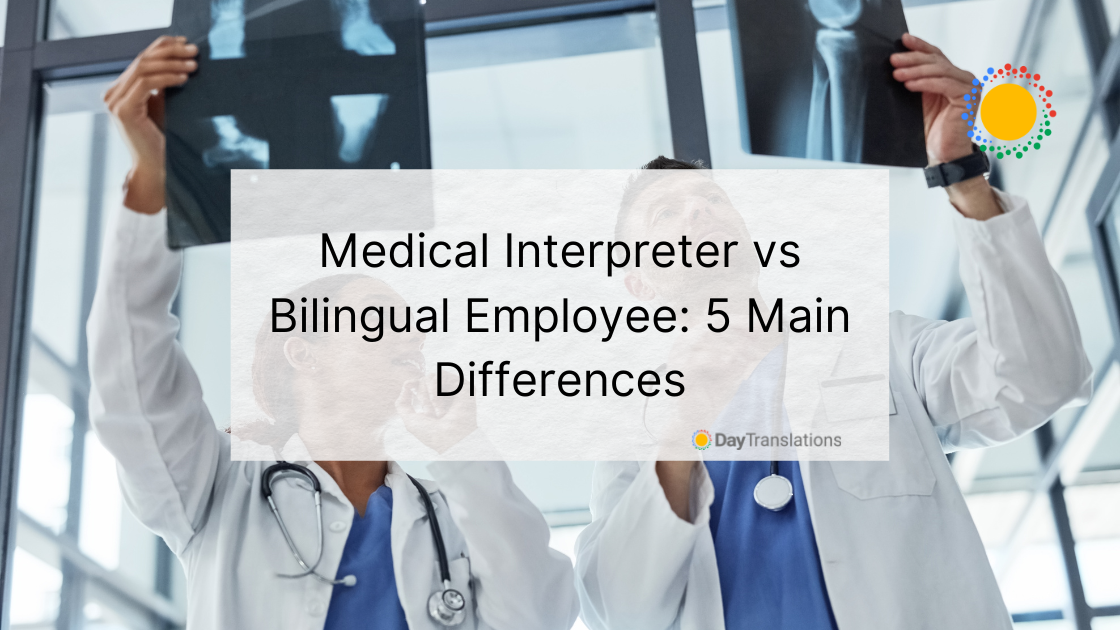In the United States, over 60 million people speak a non-English foreign language as their primary tongue. Because of this, it’s inevitable that English-speaking doctors come across LEP (Limited English Proficiency) patients in their medical practice regularly. Because the health of the patient is at stake, medical providers need to ensure the best communication possible and provide a medical interpreter at all times.
However, busy schedules often make it impossible for the doctor and patient to be served by video or over-the-phone interpreting services. In such instances, an in-person medical interpreter is the only option and, too often, a bilingual co-worker steps in as the translator.
This is a legally risky decision that can result in misdiagnosis and even death. Hospitals are legally liable if amateur bilingual staff members add or omit a word, phrase or instruction here and there which could severely impact care and elevate patient readmission rates.
Here are the five main distinctions between a medical interpreter and a bilingual employee that all medical staff should be made aware of:
1. Different Training and Backgrounds
Having an ease in speaking in more than one language is a wonderful skill set. Not only does it grant the multilingual person an understanding of another culture, but that person can serve as a “bridge.” The problem is when hospital staff make the assumption that a bilingual can serve as a medical interpreter.
The truth is professional medical interpreter has vastly more evolved language skills than a bilingual amateur interpreter. An official career, interpreters are trained and have the experience to linguistically connect the two parties in question. This naturally leads to high-end professionalism and, ideally, seamless communication between the doctor and patient in a hospital setting. The professional also understands that cultural customs, norms and nuances are just as important as language mastery, and is adept in addressing these.
Moreover, the interpreter’s field of medical specialization ensures the relevant terminology is accurately conveyed. Because of this, a professional has the confidence to expertly translate the words spoken, whereas the amateur will likely make mistakes. Such mistakes can have dire consequences, as just one medical term can throw off the right diagnosis and treatment, and hurt the patient.
2. Professionalism vs A Casual Presence
Hospital staff are often trained to connect with the patient and make him/her feel at ease. However, this approach can have adverse effects when interpreting. Comforting the patient and caring for them comes natural to hospital staff. However, it’s best to have the medical interpreter keep a professional distance and not focus on comforting the patient.
By maintaining his/her focus and interpreting the conversation, word for word, the interpreter is ensuring quality medical translation services and accuracy. When interpreters are seen as being too friendly, the two parties may perceive a bias slant in the conversation. Not only is this highly unprofessional, for legal reasons, interpreters should never connect with the patient on a one-to-one basis. The danger here is that the interpreter may get personally invested in the conversation itself.
3. Focus of a Medical Interpreter
While interpreting, the medical interpreter will face multiple ways to translate a phrase. Whereas a bilingual employee might take freedoms while translating, a professional interpreter honors the terminology to the best of his/her ability. To an untrained ear, some language differences may seem minor but a professional linguist may see widely different interpretations of these. Such understandings can make or break a translation. An accurate translation goes way beyond just words and context — tone and register must be conveyed as well.
4. Retention and Memory
A professional medical interpreter worth his/her salt has higher-than-average concentration, memory and retention. Unlike amateurs, professionals retain and absorb a lot of information in mere moments, while maintaining focus and accuracy. This is typically not the case for amateur interpreters.
At the same time, in most healthcare settings, doctor-patient conversations can be at a quick pace, which can rattle an amateur. The rate of speech in an urgent medical situation, in particular, can throw off an amateur completely. Not so with professional interpreters. Their expertise in high-risk situations enables them to keep up with the fast pace conversation.
The amateur, in turn, will most likely make mistakes and expose his/her lack of confidence that can trigger frustration. When the situation is especially urgent, having the details of the communication be translated in the right tone and register is vital.
5. Principles
A difficult profession in its own right, interpreting maintains its own industry best practices, knowledge bases and codes of conduct. A bilingual staffer, ignorant of standard norms in interpreting, may break common codes, such as speaking in the first person. Another typical mistake reflecting unprofessionalism is frequently engaging the doctor or patient in side conversation for his/her own clarity.
A medical interpreter is trained to do the job: accurately translating the conversation between patient and doctor while keeping up with the pace of speech. A bilingual amateur, in turn, may allow his/her job relationship with the doctor influence the interpretation, even if it’s on a subconscious level. Trained interpreters are made to obey national standards of practice as well as keep to a practiced code of federal ethics. The average amateur interpreter, in turn, has received no training in industry standards.
Bringing Doctors and Patients Closer Together
While it’s reasonable to use an amateur when no professional can be found, regularly depending on the former is bad policy – pure and simple. The difference in quality of translation made by a professional compared to an amateur is stark. Assuming bilingualism is qualification enough to bring doctors and patients closer together exacts a heavy cost, especially for the patient. Hospitals focused on good quality of care and reduced patient readmission rates must recognize this. If not, the patient’s health suffers and the whole point of providing medical care is defeated. Hospitals shouldn’t play with people’s lives like this and strive to book a professional medical interpreter, whenever possible.












Rosemary Rodriguez
Posted at 06:46h, 13 JulyHi Denise great article, but remember interpreting is always spoken and translating is always written. You seem to interchange these terms and they’re not interchangeable there is a difference. This causes a huge confusion in the industry, translating is a completely different skill set from interpreting. Just because a person can interpret doesn’t mean they can translate a document into another language.